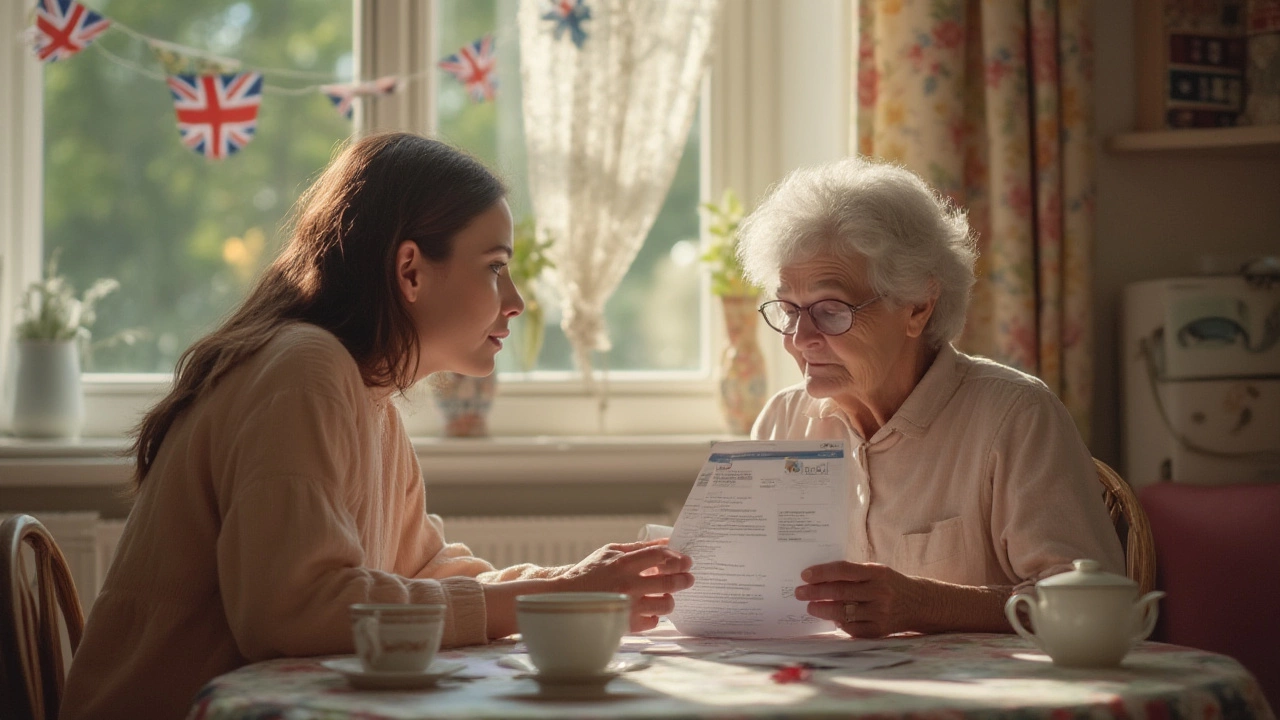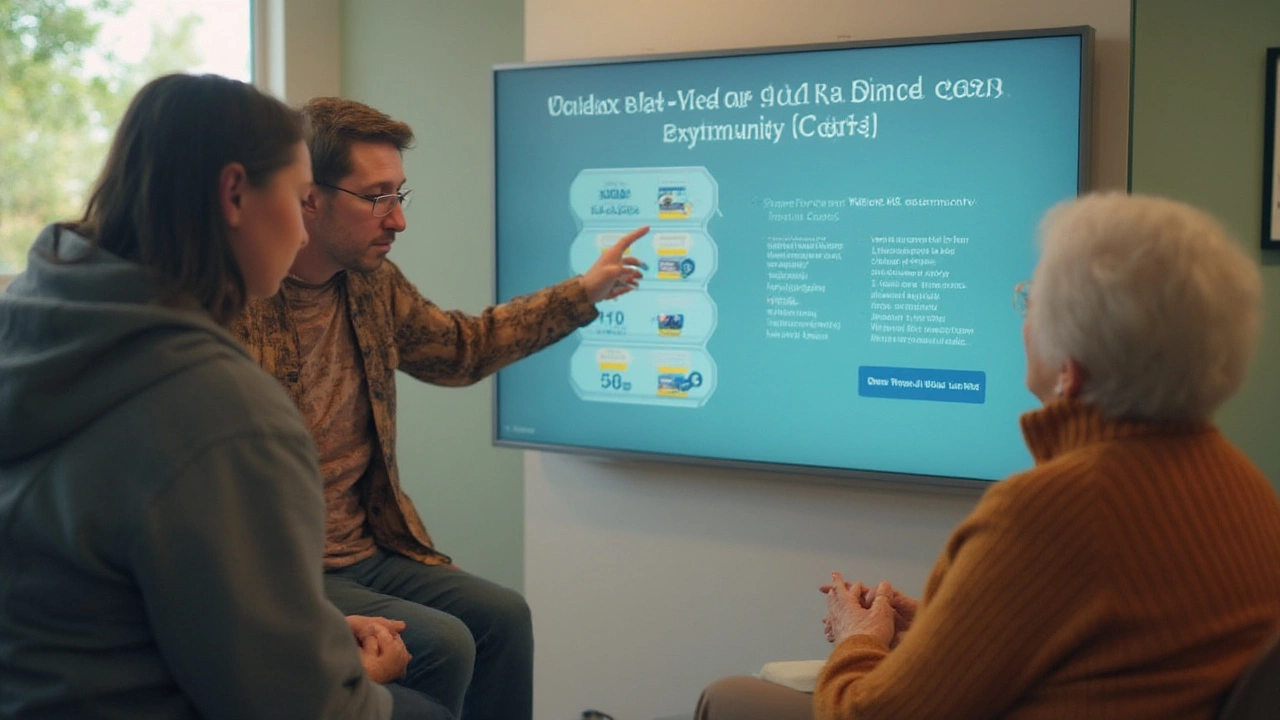Get Government Payments for Family Care: Full UK Guide 2025
 Jul, 26 2025
Jul, 26 2025
Picture this: You’re juggling school runs with Imogen, muddy walks with Rosie, and the endless daily tasks that come with caring for a loved family member who’s struggling. Maybe it’s your mum, a disabled partner, or your own child. Sadly, more than 6.5 million people in the UK are informal carers, most unpaid and under-supported. But what if I told you there’s a way the government could actually pay you—yes, pay you—to do what you’re already doing for your family?
Understanding Who Qualifies for Carer Payments
The first thing to know is that the UK government’s main support for family carers is called Carer’s Allowance. This is a weekly benefit for people who spend a considerable amount of time looking after a friend or relative. To qualify for Carer’s Allowance in 2025, you need to tick specific boxes. Firstly, the person you care for must already get at least one of these three benefits: the Disability Living Allowance (DLA) at the middle or highest care rate, Personal Independence Payment (PIP) daily living component, or Attendance Allowance. This means your loved one must already be recognised as needing extra help.
You must also be at least 16 years old, spend at least 35 hours per week caring for your family member, and not earn more than £151 per week (after tax, National Insurance, and some expenses). The government will look for proof of your relationship and caring hours. Even if you’re caring for multiple people or providing more than 35 hours, you can generally only claim Carer’s Allowance once per person.
There are some less obvious rules too. If you’re in full-time education (over 21 hours per week), you won’t qualify. And if you share care with others, only one of you can receive payment. Carer’s Allowance is taxable income, and it might affect means-tested benefits for you or the person you care for, so be sure to check before diving in. Fun fact: A government report in 2024 showed that in Scotland alone, 182,000 people claimed Carer’s Allowance, saving the NHS more than £11 billion a year in avoided care home costs.
How Much Can You Actually Get Paid?
Let’s talk numbers. In summer 2025, Carer’s Allowance pays £81.90 per week. That’s around £355 a month, paid directly into your bank account. It’s not a fortune—if you break it down, it’s £2.34 per hour for 35 hours. But for many families, that bit of support is a lifesaver. Some areas offer extra payments: in Scotland, there’s a Carer’s Allowance Supplement, a top-up of just over £270 paid twice a year. That bump alone helped over 90,000 Scottish carers last year manage energy bills, food costs, and essential travel.
There are other related benefits to explore. You might qualify for Carer’s Credit, which helps fill gaps in your National Insurance record so you don’t lose out on your State Pension. If your family is on a low income, claiming Carer’s Allowance can also increase the amount you receive in Universal Credit. Still, there’s a catch: accepting Carer’s Allowance may reduce other benefits, especially for the person you’re caring for if their severe disability premium gets stopped.
Here’s a handy table based on 2025 rates:
| Benefit | Weekly Amount | Eligibility Notes |
|---|---|---|
| Carer’s Allowance | £81.90 | 35+ hours/week caregiving; income limit applies |
| Carer’s Allowance Supplement (Scotland only) | +£270 (twice a year) | Automatic if you get Carer’s Allowance |
| Carer’s Credit | N/A (NI credits) | For those caring 20+ hrs/wk but not claiming Allowance |
If you’re providing round-the-clock care, you can also look into Support for Carers grants from charitable trusts, local Carers’ Centres, or council support. Some councils provide Direct Payments, which you can use to pay yourself or someone you trust for caring, but rules for these are stricter. And yes, you can work a part-time job or study up to 20 hours a week and still keep your Carer’s Allowance, as long as your earnings stay below the threshold.

The Step-by-Step of Getting Paid
The process is more straightforward than you might think. You apply online at gov.uk or by post with the DS700 form, but I recommend the online route—it takes about 20 minutes if you’ve got your National Insurance number and your loved one’s benefit info handy. Most applications are processed within weeks, though sometimes extra evidence or clarification is needed. During the process, don’t expect anyone to turn up at your door, but you might get asked for written confirmation of your caring hours. On approval, payments are backdated to the date of your claim.
You need to report any change of circumstances right away—if your family member goes into hospital, if your caring hours drop, if you start earning more than the income cap, or if you move abroad. The government does check records, and you can’t “double dip”—getting full pay while on holiday. Annoying, but keeping things honest is crucial. If you’re nervous about eligibility or paperwork, local Carers’ Centres and Citizens Advice are brilliantly helpful with forms and appeals. They’ve seen it all and often know the tiny mistakes that get claims rejected (like missing a crucial signature or ticking the wrong earnings box).
Some tips for first-timers: keep a weekly diary of your tasks—washing, meals, medication reminders—because you might need to prove you’re doing the hours. Make sure your bank information is up to date. If your family situation changes, update your claim immediately. And if you get turned down, don’t panic. Around 18% of initial rejections in 2023-24 were overturned on appeal after evidence was added or a technical error was fixed.
- Apply as soon as you start caring—it’s backdated, but you can miss out on payments if you delay too long.
- If working, deduct travel and pension contributions from your earnings to stay under the cap.
- Use your local Carers’ Centre—they can double-check your claim for errors.
- Set calendar reminders before key dates—especially if your loved one’s disability award is reviewed.
What Support Goes Beyond Money?
While Carer’s Allowance is useful, what families need most is often advice, backup, and real understanding. Local authorities must assess your needs as a carer if you request it. This might mean a break from caring (respite), help with household chores, or equipment to make things safer—grab rails, shower chairs, the works. Councils sometimes offer Direct Payments for respite or to pay another family member for specific tasks. Eligibility for these extras depends on the care recipient’s local authority and their own means-testing rules. Scotland and Wales have more generous packages for young carers and unpaid carers—worth checking out your local provisions.
It’s not just about adults, either. If you’re caring for a disabled child under 16, there are grants like the Child Disability Living Allowance and Direct Payments through your local council’s Children’s Services. For many people—like my neighbour Amy, caring for her autistic son—these funds have been game changers, letting her cut hours at work and hire reliable help during emergencies.
Then there’s practical support: free training in lifting safely, managing medicines, or understanding how to get power of attorney if your loved one becomes unable to make decisions. Free flu jabs, a Carer’s Passport for hospital visits, and access to talking therapy are also perks often overlooked by new carers.
If you ever feel alone or at your wits’ end, remember: you’re more than a helper. You’re a lifeline. Paid or unpaid, formal or informal, family caring holds our social fabric together. Carer’s Allowance is a nod from the state—but it’s the advice, local connections, and right to a break that really keep families strong. Don’t be shy about asking for help or claiming what you’re owed. Every hour matters, and you shouldn’t have to do it for free if there’s support out there for you.
